#710 Southern Neptune May 29, 1997
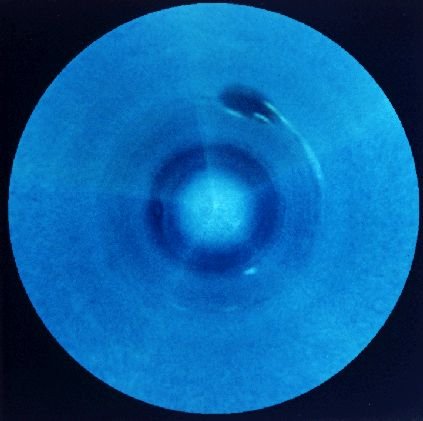
“Neptune, the Solar System's outermost gas giant planet, is 30 times farther from the Sun than Earth. Twelve years after a 1977 launch, Voyager 2 flew by Neptune and found surprising activity on a planet that receives only 3 percent as much sunlight as Jupiter. In its brief but tantalizing close-up glimpse of this dim and distant world, the robot spacecraft recorded pulses of radio emission, zonal cloud bands, and large scale storm systems with up to 1500 mile per hour winds - the strongest measured on any planet. This mosaic of 5 Voyager images shows Neptune's Southern Hemisphere. Cloud bands and the Earth-sized, late "Great Dark Spot" with trailing white clouds located at about 22 degrees southern latitude are clearly visible. The distance from the Great Dark Spot feature to Neptune's South Pole (image center) is about 17,000 miles."
Copyright: Public domain
#711 A Cosmic Snowball May 30, 1997
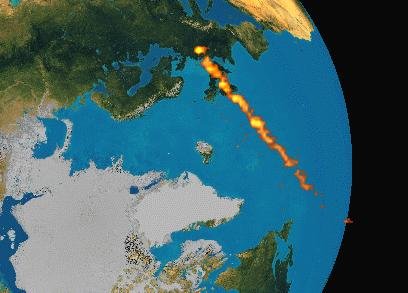
“Like cosmic snowballs, fluffy comet-like objects the size of houses and composed mostly of water-ice, may be pummeling planet Earth 5 to 30 times a minute. This controversial theory was originally proposed in 1986 by Dr. Louis Frank (U. Iowa) based on data from NASA's Dynamics Explorer 1. It is further supported by recently reported findings from the one year old POLAR spacecraft. Representing a previously unknown class of Solar System objects, these proposed small, icy comets disintegrate in the upper atmosphere at altitudes of 600 to 15,000 miles and so do not pose an impact threat to the Earth's surface or even to spacecraft in low Earth orbit. On breaking up, however, they produce a fleeting trail of clouds of water vapor. Traces of these transient, extremely high altitude clouds can be detected by down looking spacecraft designed to monitor the near-Earth environment. The suspected trail of one such cosmic snowball vaporizing over the Atlantic Ocean and Western Europe at an altitude of 5,000 to 15,000 miles is seen above. It was recorded in a 54 second exposure by POLAR's Visible Imaging System in September of 1996. A map has been added as a background for location reference. If continuous over the history of the Earth's formation, this relatively gentle cosmic snow shower would have been a major source of water for Earth's present life-nurturing oceans and possibly even a source of simple organic compounds."
Copyright: Public domain
#712 Saturn with Moons Tethys and Dione May 31, 1997
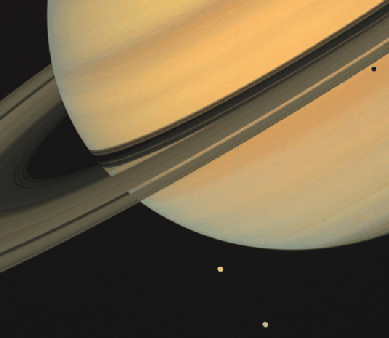
“Saturn and two of its larger moons - Tethys and Dione - were photographed by the Voyager 1 spacecraft which flew by the planet in November of 1980. This picture gives an indication of Saturn's extensive ring system, which can be seen casting a shadow on the planet, as does Tethys. Saturn's rings are composed of many chunks of ice ranging in size from a pebble to a car. The rings have several large gaps, the largest of which is clearly visible in the picture and is named the Cassini Division, after its discoverer. Saturn appears brighter than most stars in the sky, and its rings can be discerned with a small telescope. A new spacecraft - Cassini - will visit Saturn and is currently scheduled for launch later in 1997."
Copyright: Public domain
#713 M100: A Grand Design June 01, 1997
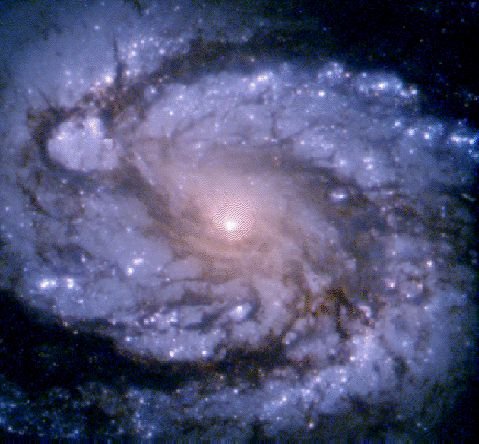
“Majestic on a truly cosmic scale, M100 is appropriately known as a Grand Design spiral galaxy. A large galaxy of over 100 billion or so stars with well defined spiral arms, it is similar to our own Milky Way. One of the brightest members of the Virgo Cluster of galaxies , M100 (alias NGC 4321) is 56 million light-years distant in the spring constellation of Coma Berenices. This Hubble Space Telescope image of the central region M100 revealing bright stars and intricate winding dust lanes was made in 1993 with the Wide Field and Planetary Camera 2. Studies of stars in M100 have recently played an important role in determining the size and age of the Universe."
Copyright: Public domain
#714 Bright Star Knots in NGC4038
Credit: June 02, 1997
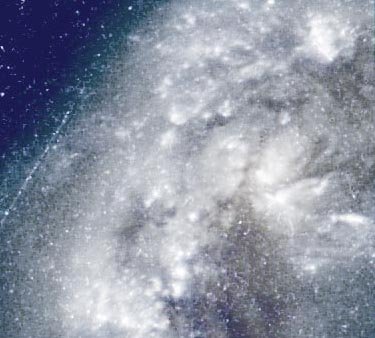
“This galaxy is having a bad millennium. In fact, the past 100 million years haven't been so good, and probably the next billion or so should be quite tumultuous. NGC 4039 was a normal spiral galaxy, minding its own business, when NGC 4038 crashed into it. The evolving wreckage, known as the "Antennae", is pictured above. As gravity pulls each galaxy apart, clouds of gas slam into each other and bright blue knots are formed. These knots are large clusters of stars imbedded in vast regions of ionized hydrogen gas. The high abundance of relatively dim star clusters is quite unlike our Milky Way's globular cluster system, though. Perhaps some of these young star clusters will go on to form globular clusters, while others will disperse through close gravitational encounters. The above picture is centered around the larger of the two interacting galaxies: NGC 4038. The diagonal streak across the upper left is unrelated to the colliding galaxies. The color contrast in the above three-color mosaic was chosen to highlight extended features."
Copyright: AURA
#715 Venus' Once Molten Surface
Credit: June 03, 1997
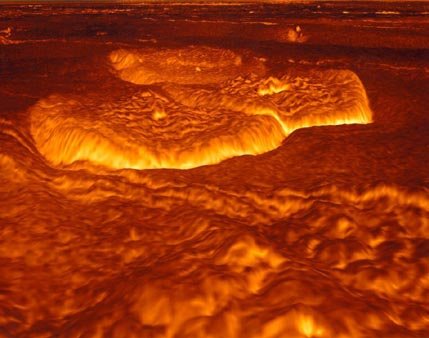
“If you could look at Venus with radar eyes - this is what you might see. This computer reconstruction of the surface of Venus was created from data from the Magellan spacecraft. Magellan orbited Venus and used radar to map our neighboring planet's surface between 1990 and 1994. Magellan found many interesting surface features, including the large circular domes, typically 25-kilometers across, that are depicted above. Volcanism is thought to have created the domes, although the precise mechanism remains unknown. Venus' surface is so hot and hostile that no surface probe has lasted more than a few minutes."
Copyright: Public domain
#716 Tarantula
Credit: June 04, 1997
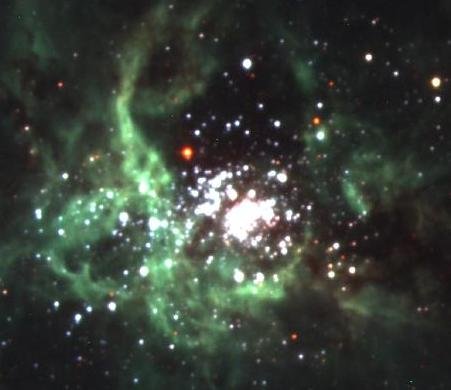
“NGC 2070 is an immense star forming region in a nearby galaxy known as the Large Magellanic Cloud. Its spidery appearance is responsible for its popular name, "The Tarantula Nebula", except that this tarantula is about 1,000 light-years across, and 165,000 light-years away in the southern constellation Dorado. If it were at the distance of the Orion Nebula, the nearest stellar nursery to Earth, it would appear to cover about 30 degrees on the sky or about 60 full moons. The spindly arms of the Tarantula Nebula surround the 30 Doradus Star Cluster which contains some of the intrinsically brightest, most massive stars known. This celestial Tarantula is also seen near the site of the closest recent Supernova."
Copyright: Public domain
#717 Small Star
Credit: June 05, 1997
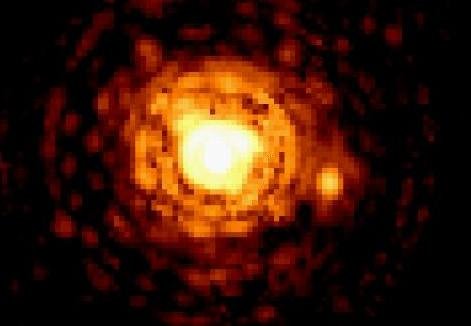
“A dim double star system cataloged as Gliese 623 lies 25 light-years from Earth, in the constellation of Hercules. The individual stars of this binary system were distinguished for the first time when the Hubble Space Telescope's Faint Object Camera recorded this image in June 1994. They are separated by 200 million miles - about twice the Earth/Sun distance. On the right, the fainter Gliese 623b is 60,000 times less luminous than the Sun and approximately 10 times less massive. The fuzzy rings around its brighter companion, Gliese 623a, are image artifacts. The lowest mass stars are classified as red dwarf stars, but even red dwarfs are massive enough to trigger hydrogen fusion in their cores to sustain their feeble starlight. Slightly less massive objects, known as brown dwarfs, can shine only briefly as their central temperatures are too low to utilize hydrogen as nuclear fuel. The present estimates of the mass of Gliese 623b are right at this red dwarf/brown dwarf border but future observations should help clarify the nature of one of our Galaxy's small stars. Dim and difficult to detect, an abundance of objects like Gl623b has been proposed as a possible solution to the mystery of "Dark Matter" in the Universe."
Copyright: Public domain
#718 Boosting Compton
Credit: June 06, 1997
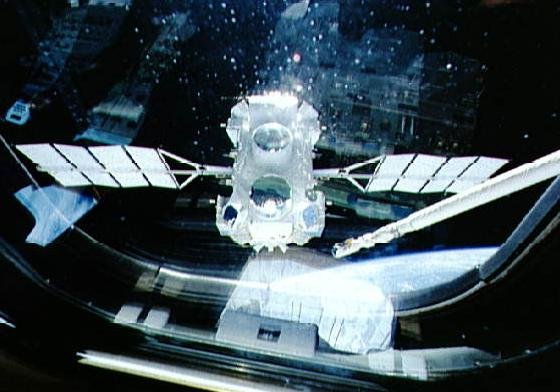
“ven great observatories need a boost from time to time -- including the orbiting Compton Gamma-Ray Observatory. Sparkling reflections and the bright limb of the Earth are visible in this 1991 window view of Compton's release into orbit by the crew of the Space Shuttle Atlantis. Named after the American Nobel-prize-winning physicist, Arthur Holly Compton, the Compton Observatory has spent the last 6 years making spectacular discoveries while exploring the Universe at extreme gamma-ray energies. From its post over 240 miles above the Earth's surface, the 17 ton satellite still experiences enough atmospheric drag to cause its orbit to deteriorate over time. But NASA controllers have just completed a complex two month long series of firings of Compton's on-board thrusters which has raised its orbit to an altitude of over 300 miles. This reboost (Compton's second in 6 years) should allow it to continue its voyage of exploration of the distant high-energy Universe until about 2007. What if you could see gamma rays?"
Copyright: Public domain
#719 Apollo 15: Driving on the Moon June 07, 1997
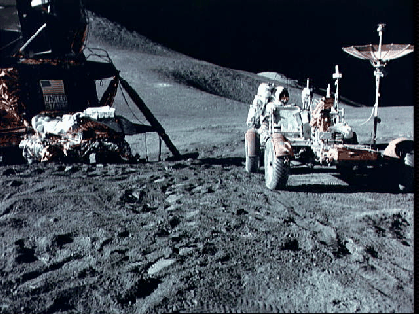
“Apollo 15 astronaut James Irwin works on the first Lunar Roving Vehicle, before he and fellow astronaut David Scott take it out for a drive. Sloping up behind the lunar module "Falcon" on the left are lunar mountains Hadley Delta and Apennine Front, while about 5 kilometers behind Irwin is St. George Crater. The explorations conducted during the Apollo lunar missions discovered much about our Moon, including that the Moon is made of ancient rock, that the Moon's composition is similar to Earth's, that life is not evident there, that the Moon underwent a great hot melting in its distant past, that the Moon has suffered from numerous impacts as shown by its craters, and that the Moon's surface is covered by a layer of rock fragments and dust."
Copyright: Public domain
Upvote! Resteem! Comment! As you like it! Thank you for attention!